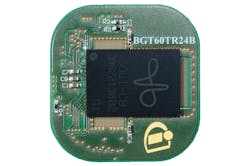Download this article in PDF format.
Developments in smart-home electronics and home automation are driving new generations of human-machine interfaces. Handheld universal remotes are extending their capabilities at the same time that remote-control functionality is finding its way into touchscreen devices and even smartphones. Voice-based control using the connected intelligence of smart speakers has gained a high profile, too, though this approach raises privacy concerns.
Gestures, which do not rely on cloud-based intelligence to understand and act on spoken word commands, are an exceptionally promising approach to home-automation control. They are evolving on several fronts.
Wearable (arm-band like) devices and visual/infrared systems have moved from control of entertainment to commanding other in-home systems. However, wearable solutions are limited as a home interface, since a physical device is not greatly superior to current handheld or smartphone-based controls. Vision-based systems also face limitations related to ambient lighting, precision, and the simple requirement that light sources and cameras cannot be hidden within a device. Thus, visual sensors will not be able to control the types of invisible devices envisioned for the in-home Internet of Things (IoT).
On the Radar
Advances in compact low-power radar, based on technology developed by Infineon for the Google Soli project, will take gesture control to a new level in addressing IoT applications in and beyond home environments. With this technology, manufacturers have an opportunity to deliver a nearly magical user experience.
Radar has already made inroads in presence detection, with applications that include automated door opening, security, and lighting control based on systems operating in the 24-GHz range. Moving to millimeter-wave frequencies, the unlicensed V-band (57-64 GHz) brings advantages of precise resolution and low likelihood of interference with nearby systems. Infineon collaborated with Google to develop a single-chip radar integrated circuit (IC) that operates in the V-band. The technology was successfully demonstrated in two iterations—first in 2015 and then in 2016 at the Google I/O Conference.
This scaled-down single-chip radar operates at V-band frequencies.
This breakthrough technology is now available to developers of consumer IoT devices. The BGT60TR24B single-chip radar is compact, measuring 9 × 12.5 × 0.8 mm (see figure). It incorporates two transmit (Tx) channels, four receive (Rx) channels, and antenna. Moreover, the sensing range is as high as 10 m.
Tthe BGT60TR24B draws just 0.054 W in sensing mode and includes extensive power-management and idle modes. Wake-up and duty cycles can be programmed to further minimize power usage in battery-powered devices as well as limit the active mode for in-wall and tabletop devices likely to be used for home-automation applications.
The ability of radar to distinguish between two closely spaced targets (or range resolution) improves with bandwidth frequency. In the V-band, with 7 GHz of available bandwidth, it is possible to achieve a range resolution of 2 cm. This can be extended to sub-millimeter precision using advanced signal processing to a level that allows recognition of overlapping fingers. Millimeter-wave sensors also have greater sensitivity to detect slow-moving objects and, as noted, large attenuation of the signal due to path loss reduces the likelihood of interference with other sources.
Potential Radar-Chip Applications
Early demonstrations of the 60-GHz radar chip include a smart watch and a wireless speaker. In the latter demo, developers working with Google showed control of the on/off and volume functions. Another team has shown a prototype cabinet with locks opened by hand gestures. It’s not hard to imagine controlling room temperature, lighting levels, and other in-home systems we use today.
With the high resolution available in V-band radars, controls can range from sweeping hand gestures to finger-sized commands such as pinching and snapping. At this level of precision, radar-based gesture control ultimately may allow designers to develop products with no visible controls at all.
The 60-GHz radar band also can operate through plastic (polycarbonate) surfaces, creating opportunities for gesture-operation of concealed devices in a home. Science-fiction movies showing homes of tomorrow with no visible light sources aren’t far away. We have the technology to embed LEDs anywhere and now we have a touchless control mechanism.
Ultimately, operation of devices that exist today is just the beginning of a revolution in human-interface design. As the digital and real worlds converge around systems designed to improve people’s lives, seamless human-machine interaction will provide a vital connection to new types of devices and services powered by the IoT. V-band radar offers engineers a path to define next-generation interfaces to an array of automation devices we have just begun to imagine.


